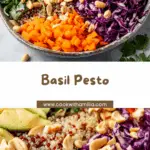Basil pesto is a classic Italian sauce that combines fresh basil leaves, garlic, pine nuts, Parmesan cheese, and olive oil into a vibrant, flavorful paste. Originating from Genoa in the Liguria region of Italy, this uncooked sauce is traditionally prepared using a mortar and pestle, though modern methods often employ a food processor for convenience. Its rich, aromatic profile makes it a versatile addition to various dishes, from pasta to sandwiches.
Why You’ll Love This Recipe
- Fresh and Flavorful: The combination of fresh basil and garlic provides a burst of flavor that enhances any dish.
- Quick and Easy: With minimal ingredients and preparation time, this recipe is perfect for both novice and experienced cooks.
- Versatile Use: Beyond pasta, basil pesto can be used as a spread, dip, or marinade, adding depth to numerous recipes.
- Customizable: Adjust the ingredients to suit dietary preferences or to experiment with different flavor profiles.
Ingredients
(Tip: You can find the complete list of ingredients and their measurements in the recipe card below.)
- Fresh basil leaves
- Garlic cloves
- Pine nuts
- Parmesan cheese, grated
- Extra-virgin olive oil
- Salt
- Black pepper
Directions
- Prepare the Ingredients: Wash and dry the basil leaves thoroughly. Peel the garlic cloves.
- Toast the Pine Nuts: In a dry skillet over medium heat, toast the pine nuts until golden brown, stirring frequently to prevent burning. Remove from heat and let them cool.
- Blend the Ingredients: In a food processor, combine the basil leaves, toasted pine nuts, and garlic. Pulse until coarsely chopped.
- Add Cheese and Oil: Add the grated Parmesan cheese to the mixture. While the processor is running, slowly drizzle in the olive oil until the pesto reaches a smooth, creamy consistency.
- Season: Taste the pesto and season with salt and black pepper as desired.
Servings and Timing
- Servings: This recipe yields approximately 1 cup of pesto, sufficient for 4 servings when mixed with pasta.
- Preparation Time: 10 minutes
- Cooking Time: 5 minutes (for toasting pine nuts)
- Total Time: 15 minutes
Variations
- Nut Substitutes: Replace pine nuts with walnuts, almonds, or cashews for a different flavor and texture.
- Cheese Alternatives: Use Pecorino Romano or a blend of hard cheeses to vary the taste.
- Herb Mix: Incorporate other herbs like parsley or cilantro alongside basil for a unique twist.
- Vegan Option: Omit the cheese or use a plant-based alternative to make the pesto vegan-friendly.
Storage/Reheating
- Refrigeration: Store the pesto in an airtight container in the refrigerator for up to 5 days. To prevent oxidation, pour a thin layer of olive oil on top before sealing.
- Freezing: Freeze the pesto in ice cube trays or small containers for up to 3 months. Thaw in the refrigerator before use.
- Reheating: Gently warm the pesto over low heat if desired, but avoid high temperatures to preserve its fresh flavor.
FAQs
What is the origin of basil pesto?
Basil pesto, known as “pesto alla genovese,” originates from Genoa in the Liguria region of Italy. The term “pesto” comes from the Italian word “pestare,” meaning to pound or crush, referring to the traditional method of preparation using a mortar and pestle.
Can I use dried basil instead of fresh?
Fresh basil is essential for authentic pesto, providing the vibrant flavor and aroma characteristic of the sauce. Dried basil lacks the necessary moisture and potency, resulting in a less flavorful pesto.
What can I use if I don’t have pine nuts?
If pine nuts are unavailable, you can substitute them with walnuts, almonds, or cashews. Each nut imparts a distinct flavor, allowing for customization of the pesto to your taste preferences.
Is it necessary to toast the pine nuts?
Toasting pine nuts enhances their flavor, adding depth to the pesto. While not mandatory, this step is recommended for a richer taste.
How can I prevent my pesto from turning brown?
Oxidation causes pesto to brown. To minimize this, ensure the basil leaves are dry before blending, and store the pesto with a thin layer of olive oil on top in an airtight container.
Can I make pesto without cheese?
Yes, you can omit the cheese for a dairy-free version. To compensate for the flavor, consider adding nutritional yeast or a dairy-free cheese alternative.
What type of pasta pairs best with pesto?
Pesto pairs well with various pasta types, including spaghetti, linguine, and penne. Traditional Ligurian dishes often use trofie or trenette pasta with pesto.
Can I use a blender instead of a food processor?
A blender can be used, but it may require more liquid to achieve the desired consistency. A food processor is generally preferred for better control over the texture.
How do I adjust the consistency of my pesto?
If the pesto is too thick, add more olive oil gradually until the desired consistency is reached. If it’s too thin, incorporate additional basil leaves or cheese.
Is pesto suitable for freezing?
Yes, pesto freezes well. Portion it into ice cube trays or small containers for convenience, and thaw in the refrigerator as needed.
Conclusion
Basil pesto is a timeless sauce that brings a burst of fresh flavor to a variety of dishes. Its simplicity and versatility make it a staple in many kitchens. By following this recipe, you can create a delicious, homemade pesto that surpasses store-bought versions in taste and quality. Whether tossed with pasta, spread on bread, or used as a marinade, basil pesto adds a delightful touch to any meal.



Your email address will not be published. Required fields are marked *